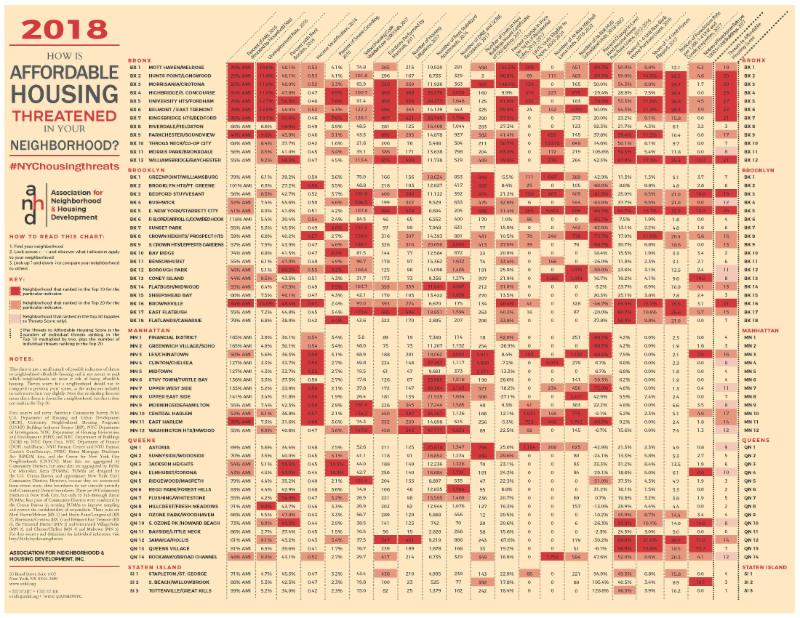New Affordable Housing Analysis Shows Where Displacement Risk Is Most Severe in New York City
Every year, ANHD collects a variety of indicators of key threats to affordable housing in the city that illustrate issues and patterns that are specific to each community district, as well as the city as a whole. Neighborhood-level statistics help community groups and policy makers develop effective strategies to address the affordable housing crisis comprehensively.
| New York, NY – Today, the Association for Neighborhood & Housing Development (ANHD) released the 2018 edition of their annual housing risk chart, How is Affordable Housing Threatened in Your Neighborhood?
Every year, ANHD collects a variety of indicators of key threats to affordable housing in the city that illustrate issues and patterns that are specific to each community district, as well as the city as a whole. Neighborhood-level statistics help community groups and policy makers develop effective strategies to address the affordable housing crisis comprehensively. Click here to download the 2018 chart, How is Affordable Housing Threatened in Your Neighborhood? This year’s housing risk chart shows displacement is a growing crisis for New Yorkers as more and more communities confront this rising threat. For example:
“The crisis of affordable housing is so much part of the daily experience of almost all New Yorkers that it’s the water we swim in. But some people and some neighborhoods are experiencing the crisis and the displacement pressure more severely, and with more devastating consequences to their families and their communities.” said Benjamin Dulchin, the Executive Director of the Association for Neighborhood and Housing Development. “This year’s Housing Risk Chart shows the many ways and many neighborhoods where City policy must do a better job preserving our affordable housing.” “The data presented by ANHD highlights the critical need to protect and preserve existing affordable housing. Low-income residents of East Harlem, Central Harlem, and neighborhoods throughout the city are increasingly at-risk of losing their homes and being uprooted from their communities,” said Chris Cirillo, Executive Director at Ascendant Neighborhood Development Corporation. “The City must re-double its housing preservation efforts to ensure that there is no net loss of affordable housing and that residents can stay in the neighborhoods that they call home.” “Sound the alarm! The release of the risk chart confirms the severity of our affordable housing and homelessness crisis across the city. The decision to rezone black and brown communities is a triage approach that will only exacerbate displacement to already vulnerable neighborhoods like Highbridge and the South Concourse. This crisis will continue to worsen, unless we follow the lead of organizations on the ground,” said Carmen Vega-Rivera, a Leader with CASA: Community Action for Safe Apartments. “Working class and moderate income communities, particularly neighborhoods of color, are increasingly being victimized by policies that encourage displacement of families who have made those communities home, in some cases for generations,” said Delsenia Glover, Director of Education and Organizing at Tenants & Neighbors. “Escalating rents and loopholes in the rent laws, like vacancy bonuses and preferential rents, are creating rapid turnover of apartments and even whole streets and neighborhoods like a gentrification steamroller. The creation and retention of affordable housing has never kept pace with the number of New Yorkers in need of it, but the chasm between those numbers is growing like a wildfire. What we need is a pro-active and deeply affordable city housing plan to preserve an economically and racially diverse New York City.” “We are gravely concerned about the accelerating loss of rent-regulated housing throughout Harlem,” said Larry Wood of the Goddard Riverside Law Project. “The data collected by ANHD highlights the scale of this loss, which we have observed as advocates and our clients continue to experience first-hand as they struggle to preserve their homes and maintain their communities. We are hopeful that the newly implemented Right to Counsel program will slow the loss of rent-regulated housing in Harlem, but we have to remain vigilant and continue fighting to preserve affordable housing.” “What we are seeing in HUD-subsidized housing in gentrifying neighborhoods is that landlords are avoiding entering into long-term contracts or extensions of their contracts, which leaves residents wondering how long their housing will remain affordable,” said Gloria Villatoro, Vista Organizer at UHAB. “The tenants who suffer the most are the elderly, people with disabilities, or formerly homeless families. Stable housing is particularly important for these residents, and living with insecurity takes a serious toll on them.” |
|
|
|
About the Association for Neighborhood and Housing Development: The Association for Neighborhood and Housing Development (ANHD) is the umbrella organization of 100 non-profit affordable housing and economic development groups, serving low- and moderate-income residents in all five boroughs of New York City. Since its founding in 1974, ANHD has been key in making NYC’s community development sector among the most effective in the US, providing comprehensive training, robust capacity-building and apprenticeship programs, and high-impact policy research. In the past 25 years, ANHD’s non-profit members have built over 120,000 units of affordable housing in our city’s most distressed neighborhoods. Additional information may be found at www.anhd.org| Twitter: @ANHDNYC | Blog: https://anhd.org/blogs/ | Facebook: www.facebook.com/anhdny | LinkedIn: https://www.linkedin.com/company/association-for-neighborhood-&-housing-development-anhd-/ ### |
